Abstract
The Dazhuyuan Formation (northern Guizhou) is the host stratum for bauxite deposits and enriched with critical metals like Li. We investigated sedimentary processes of the formation using detrital zircon geochronology and whole-rock geochemistry. From bottom to top, the formation comprises iron-rich claystone (IC), clastic bauxite (CB), massive bauxite (MB; where Li is enriched (1555–4210 ppm)), and clastic claystone (CC). From lower part to upper part of the formation, the sedimentary environment becomes more reducing, transitioning from continental to marine–continental facies. The P1d exhibit rare-earth-element (REE) distributions similar to the Hanjiadian Formation. The Hanjiadian Formation detrital-zircon U–Pb ages reach ~960 and ~760 Ma; the IC and CB layers show similar results. The dominant peak of detrital-zircon ages for the MB and CC layers occurs at ~960 Ma, while the ~760-Ma dominant peak disappears. Numerous zircons are aged 1030–1150 Ma, which substantially diverges from the Hanjiadian Formation. All layers exhibit different REE distributions and detrital-zircon age distributions than the Huanglong Formation, indicating that the formation is the primary source for the Dazhuyuan Formation. The MB and CC layers receive contributions from other sources.
1. Introduction
The aluminum-bearing rock series is a significant type of sedimentary sequence that plays a crucial role in the global distribution of mineral resource [1]. China possesses abundant bauxite resources, with proven reserves ranking among the top globally [2]. In the northern Guizhou of southwestern China, the aluminum-bearing rock series is widely distributed, forming a major bauxite province (Figure 1) [3]. Concurrently, these aluminous sequences commonly exhibit enrichment of critical metal elements like lithium (Li), scandium, gallium, and rare earth elements (REEs), thereby holding significant scientific and economic values [4,5,6].
As the lightest metal with active chemical properties, Li is widely used in new energy, electric vehicles, aerospace, medical care, and other fields [7,8,9,10]. Recently, China has achieved advancements in the sedimentary-type Li resource. In the northern Guizhou region (southwest China; Figure 1a), in particular, the Lower Permian Dazhuyuan Formation (P1d) is commonly associated with Li enrichment [11,12,13,14]. For example, in the Xinmin area, the Li content of P1d can reach up to 3521 ppm [11]. The Li content in the local layers of P1d in the Shixi area is as high as 3550 ppm [12]. The Li content in the local layers of P1d in the Danping area is as high as 3290 ppm [15]. However, the Li distribution across sections shows a marked heterogeneity [16], typically concentrating in the upper sections [14]. Previous studies extensively investigated the P1d, focusing on its geological characteristics [17,18], sedimentary environments [19,20], material sources [11,21], and distribution of critical metals like lithium [14,22]. However, the sedimentation features within the P1d remain poorly understood, hindering the comprehensive understanding of the sedimentary processes controlling the P1d and the associated critical metals in this region.
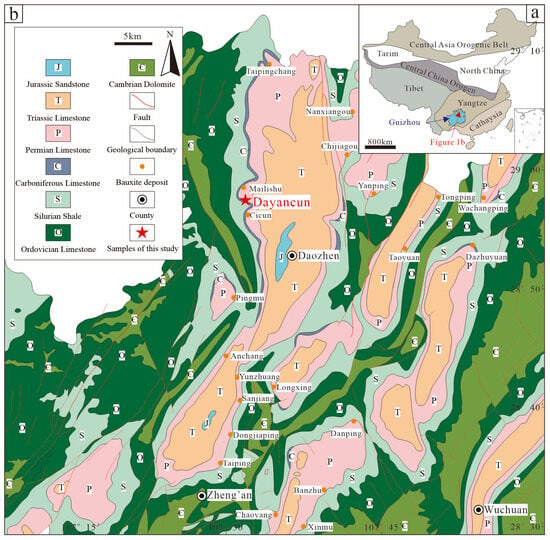
Figure 1.
(a) Location of Guizhou Province in China; (b) Geological map of Bucheon–Zhengan–Daojin area (modified after [15,23]).
This study investigates the Lower Permian Dazhuyuan Formation (P1d) at the Dayancun section, situated on the western limb of the Daozhen syncline in northern Guizhou (Figure 1b), and employs whole rock geochemistry and detrital zircon U–Pb geochronology to explore the P1d sedimentary processes. Samples were collected based on detailed section logging to ensure coverage of all lithological units. The study aims to clarify the vertical distribution of lithium in the Dayancun section and to identify variations in sedimentary environments and material sources across different lithostratigraphic intervals, which hold significant implications for metallogenic theory and prospecting of lithium deposits in this region.
2. Geologic Setting
The northern Guizhou area is located in the southwest of the Yangtze Plate and exhibits a regional tectonic evolution consistent with that of the Yangtze Plate [17,24,25]. During the Cambrian and the Ordovician, the Yangtze Plate was relatively stable in a shallow marine environment [26], providing the material basis for Li enrichment and mainly depositing carbonate rocks, shale, and siliceous rocks [27]. The area was affected by the Caledonian movement during Late Silurian to Early Devonian and uplifted and denuded to form a quasi-plain topography. Only the shale of the Hanjiadian Formation (S1–2hj) was preserved, resulting in preliminary Li enrichment in the paleo-weathering crust [28]. During the late Carboniferous, the crust was uplifted and eroded. Moreover, only the Huanglong Formation (C2h) was locally developed, mainly comprised limestone, and potentially accompanied by the hydrothermal activity that introduced additional Li [29]. Two marine transgression events occurred during the Late Carboniferous to Middle Permian [30,31], consequently transforming the area into a semi-enclosed bay sedimentary environment and further enhancing the Li enrichment [32]. The P1d is an aluminous rock series with overlying strata of carbonaceous shale and limestone. It underwent multiple tectonic movements, including the Indo-China movement resulting in the marine to terrestrial environment transformation [25,33], the folding and rupture caused by the Yanshan movement [34], and the regional uplift and rupture caused by the Himalayan movement [25].
The Dayancun section located in the western part of the Daozhen syncline (Figure 1b) belongs to the Mailishu bauxite deposit. From base to top, the exposed strata of the Dayancun section are P1d, Liangshan Formation (P1l), and Qixia Formation (P2q). The P1d in this section can be divided into four layers based on lithologic changes (Figure 2). The bottom layer is iron-rich claystone (IC) that is reddish-brown with occasional gray-green thin layers and contains carbonaceous clasts and oolitic particles with more than 1.8 m thickness. Above the IC is clastic bauxite (CB) that is gray to grayish green and contains carbonaceous clasts and oolites with approximately 2 m of thickness. The following layer is massive bauxite (MB) that is grayish black to black and with minor carbonaceous clasts and oolites and approximately 1.5 m thickness. The Li element is most enriched in this layer. The top is clastic claystone (CC), which is gray to purplish red, contains carbonaceous clasts and oolitic grains, and is approximately 2.3 m thick. The overlying stratum, the Lower Permian Liangshan Formation (P1l), is grayish black carbonaceous shale with approximately 0.1 m of thickness. The top of the section is a gray black limestone of the Middle Permian Qixia Formation (P2q). See Table 1 for the details of the samples.
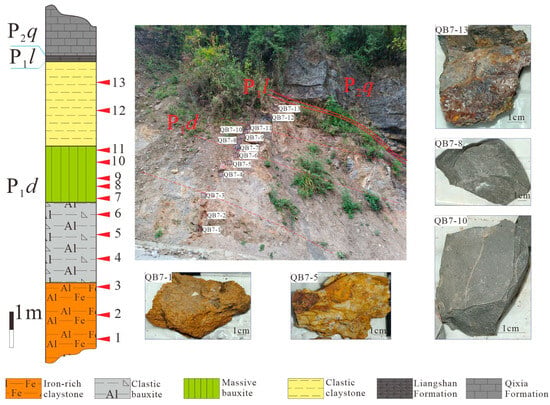
Figure 2.
The distribution of lithology and samples of the Dayancun section.

Table 1.
Sample description from the Dayancun section.
2.1. Sampling and Analytical Methods
Although the Mailishu bauxite deposit is relatively small, its Dayancun section reveals a notable Li enrichment in the upper part of the Dazhuyuan Formation (P1d), with a maximum concentration of 4210 ppm documented in this study. This high-grade enrichment establishes the profile as an ideal profile for investigating Li enrichment mechanisms in aluminous rock series. The section’s well-defined lithological stratification facilitates a detailed examination of elemental geochemical behavior across distinct sedimentary layers. Furthermore, a marked contrast is observed between the profile’s relatively low bauxite grade and its intense lithium enrichment. This distinctive geochemical decoupling provides critical insight into the differential enrichment processes of critical metals within aluminous sequences.
Thirteen samples were collected from the P1d outcrop of the Dayancun section (Figure 2) for whole-rock geochemical analysis, covering all lithological units of the profile. One supplementary sample from an exposed Hanjiadian Formation (S1–2hj) outcrop about 30 m from the main profile for provenance comparison. The detrital zircons were selected from four layers of P1d and one sample of S1–2hj. U–Pb dating and trace element analyses were then performed on the selected detrital zircons. The abovementioned analyses were conducted at Wuhan Sample Solution Analytical Technology Co., Ltd. Furthermore, thin sections from the four layers were prepared for mineral identification and analysis using scanning electron microscopy-energy dispersive spectroscopy (SEM-EDS) (Thermo Fisher Scientific, Brno, Czech Republic).
2.2. Whole-Rock Major and Trace Element Analyses
Thirteen samples were ground to 200 mesh and dried. The major element contents of the whole rock were analyzed using a Rigaku Primus II wavelength-dispersive X-ray fluorescence spectrometer (WD-XRF) (Rigaku Corporation, Tokyo, Japan). The theoretical α coefficient method was applied to correct for matrix absorption-enhancement effects and convert spectral line intensities into elemental concentrations. All major element analysis lines are kα [35]. The standard curve uses the national standard material GBW07101-14, GSS07401-08, and GBW07302-12 [36,37]. The relative standard deviation (RSD) is less than 2%.
The trace element contents of the whole rock were analyzed using an inductively coupled plasma mass spectrometer (ICP-MS). 50 mg of sample powder was placed in a Teflon bomb via a two-step acid dissolution process to achieve complete dissolution [38]. Procedural blanks were prepared alongside to monitor potential contamination during sample preparation. Quantitative analysis was conducted using external calibration with a series of multi-element standard solutions. Indium (In) was used as an internal standard to correct for instrumental drift and matrix effects. The standard curve uses the international reference materials AGV-2, BCR-2, BHVO-2, and RGM-2 [35,39]. The relative standard deviation (RSD) is less than 10%.
2.3. Laser Ablation Inductively Coupled Plasma Mass Spectrometry Detrital Zircon U–Pb Dating and Trace Element Analyses
U–Pb zircon dating was conducted using Agilent 7900 ICP-MS (Agilent Technologies, Santa Clara, CA, USA) with the GeolasPro Laser Ablation System (193 nm excimer laser) at Wuhan Sample Solution Analytical Technology Co., Ltd., Wuhan, China. The analyses were performed with 32 µm laser spot size and 5 Hz frequency. The data signal of the sample was composed of a blank signal lasting approximately 20 s and a sample signal lasting 50 s. Zircon 91,500, GJ-1 and glass NIST610 were used as the external standards for isotopic fractionation correction and calculation monitoring, respectively [40,41,42,43].
The data were processed using the ICPMSDataCal Program v12.2 [44] to determine the U–Pb ages. Subsequently, the Isoplot/Ex_ver3 program [45] was utilized to draw the concordia diagrams and calculate the weighted mean ages. Analyses with a discordance lower than 10% were adopted for age statistics to exclude 15 unreliable data points, and the reported weighted mean ages were presented with uncertainties expressed as 1 sigma, which represent the standard error of the mean.
3. Results
3.1. Mineralogical Features
The SEM-EDS analysis shows that the aluminous rock series is composed of diaspore, kaolinite, illite, chlorite, hematite, anatase, quartz, and other minerals (Table 2, Figure 3). In the bottom IC layer, hematite and kaolinite are the dominant minerals, with hematite occurring as massive aggregates and exhibiting zonal textures (Figure 3a). The CB layer is primarily composed of kaolinite, illite, and diaspore, where kaolinite and illite are intergrown (Figure 3d). The MB layer is dominated by diaspore, kaolinite, and chlorite, with diaspore presenting a platy shape (Figure 3g). The CC layer consists mainly of kaolinite, with hematite occurring as euhedral to subhedral grains (Figure 3j).

Table 2.
Semi-quantitative mineralogical analyses of the Dayancun section (wt.%).
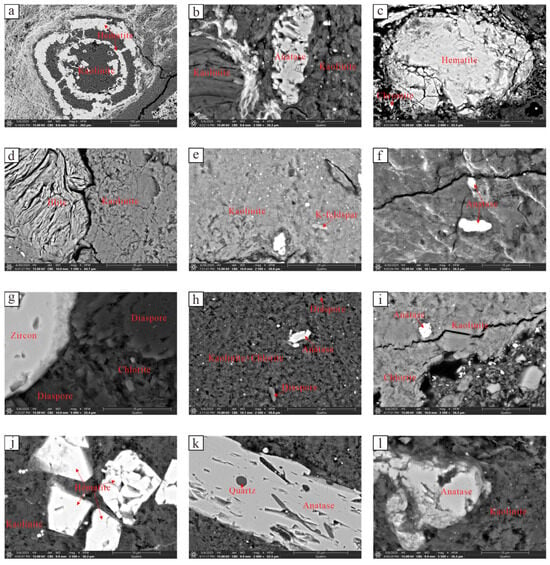
Figure 3.
SEM images from the Dayancun Formation. (a–c): SEM images of iron-rich claystone; (d–f): SEM images of clastic bauxite; (g–i): SEM images of massive bauxite; (j–l): SEM images of clastic claystone.
3.2. Whole-Rock Major Elements
The major elements with the highest contents were SiO2, Al2O3, and TFe2O3, with a total content of 75.78% to 84.17% (Supplementary Materials S1). The distribution of the major elements in the section was uneven. The Al2O3 content ranged from 11.87% to 49.65% and was highly enriched in the MB layer (Figure 4). The overall fluctuation of the SiO2 content was relatively small, that is, from 14.76% to 44.72% (Figure 4). The MgO content ranged from 0.11% to 2.82% and mainly enriched in the MB and CC layers (Figure 4). The TFe2O3 content ranged from 0.43% to 49.15% and was mainly enriched in the IC layer (Figure 4). K2O was mainly enriched in the IC layer (Figure 4).
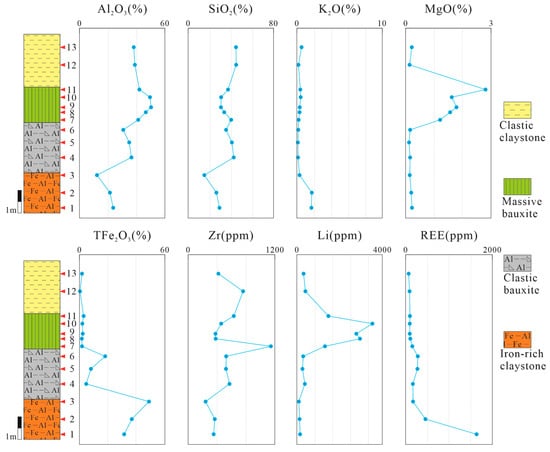
Figure 4.
The distribution of selected major and trace elements from the Dayancun section.
3.3. Whole-Rock Trace and Rare Earth Elements
Supplementary Materials S1 presents the trace element concentrations in the P1d samples from the Dayancun section. The contents of most elements exhibited uneven distributions in the section. For example, the Zr content ranged from 241.3 to 1145.3 ppm and was enriched in the MB layer (377.4–1145.3 ppm; Figure 4) but lower in the IC layer (241.3–368.2 ppm; Figure 4). The Li content ranged from 105.2 to 4209.6 ppm and was highly enriched in the MB layer (1555.5–4209.6 ppm; Figure 4) but much lower in the IC layer (105.2–170.0 ppm; Figure 4). The ∑REE contents ranged from 30.5 to 1527.2 ppm and was highly enriched in the IC layer (137.4–1527.2 ppm; Figure 4) but much lower in the CC layer (34.8–35.1 ppm; Figure 4), suggesting that ∑REE was enriched in the lower section. The Co content ranged from 0.2 to 44.8 ppm and mainly enriched in the IC (14.2–44.8 ppm; Supplementary Materials S1). The Ni content ranged from 5.6 to 70.3 ppm and was mainly enriched in the IC and CB (37.7–70.3 ppm; Supplementary Materials S1). The Cu content ranged from 4.7 to 70.2 ppm and mainly enriched in the IC and CB (19.2–70.2 ppm; Supplementary Materials S1).
3.4. Characteristics of Element Migration
High-field-strength element (HFSE) Zr, which is chemically stable, was selected as the conservative element to calculate the mass transfer coefficient (τ) of elements. (Figure 5). Among the major elements, the mass transfer coefficients (τ) of both SiO2 and MgO are negative, indicating their overall removal throughout the profile. The τ values of Al2O3 are also predominantly negative; however, two samples in the MB layer exhibit positive values, suggesting local enrichment of Al2O3 within this layer. For the trace elements, Li consistently shows positive τ values, with a notably high value of 35.7 in the MB layer, demonstrating significant enrichment. Except for a single sample at the profile base (τ = 1.2), the REEs exhibit negative τ values, indicating their general depletion and enrichment, which is confined solely to the bottom.
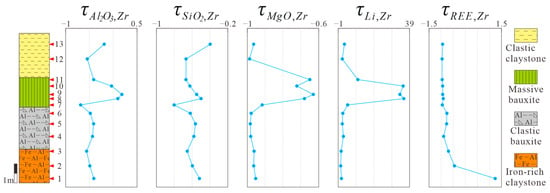
Figure 5.
The mass transfer coefficients of selected major and trace elements from the Dayancun section (The data of S1-2hj from [46]).
3.5. U–Pb Dating and Detrital Zircon Trace Element
Based on the zircon cathodoluminescence (CL) images (Figure 6), 222 detrital zircons were selected, and in situ U–Pb dating analysis was performed on them, with the concordant ages ranging from 3156 to 433 Ma (Supplementary Materials S2). From the zircon age distribution, 53% of the zircon ages ranged from 700 to 1200 Ma. All the detrital zircons had high Th/U ratios ranging from 0.1 to 4.9 (Supplementary Materials S2). They also had low La content (<1 ppm) (Supplementary Materials S2).
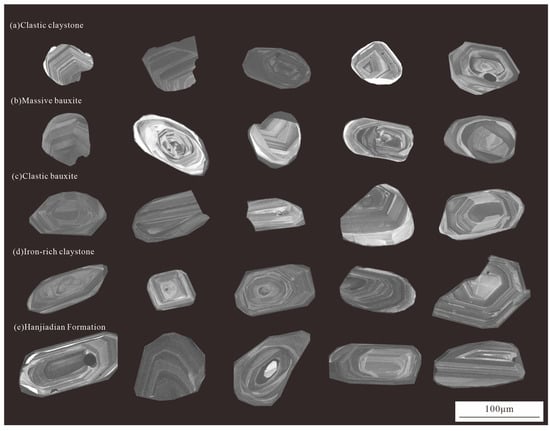
Figure 6.
Cathodoluminescence images of representative detrital zircons from the Al-bearing rock series in the Dazhuyuan Formation and the Hanjiadian Formation.
4. Discussion
4.1. Changes in Sedimentary Environments
The sedimentary environments greatly affect the element distribution, and the geochemical behaviors of the sensitive elements can be revealed by their contents and/or ratios in the environments [47,48,49].
The presence of SO42− in seawater allows for a higher Sr content. Meanwhile, Ba in river water will precipitate in BaSO4 form when mixed with seawater [50]. The Sr/Ba ratio can effectively indicate marine and terrestrial environments. Marine rocks often have Sr/Ba ratios greater than 1, while terrestrial rocks have Sr/Ba ratios less than 0.6 [51]. Comparing the IC (0.28) and CB (0.31) samples from the lower part, the MB (0.52) and CC (0.50) samples from the upper part had higher average Sr/Ba ratios (Figure 7a). Two upper part samples with Sr/Ba ratios exceeding 0.6 (Figure 7a) may reflect the enhanced seawater influence, considering different provenance inputs.
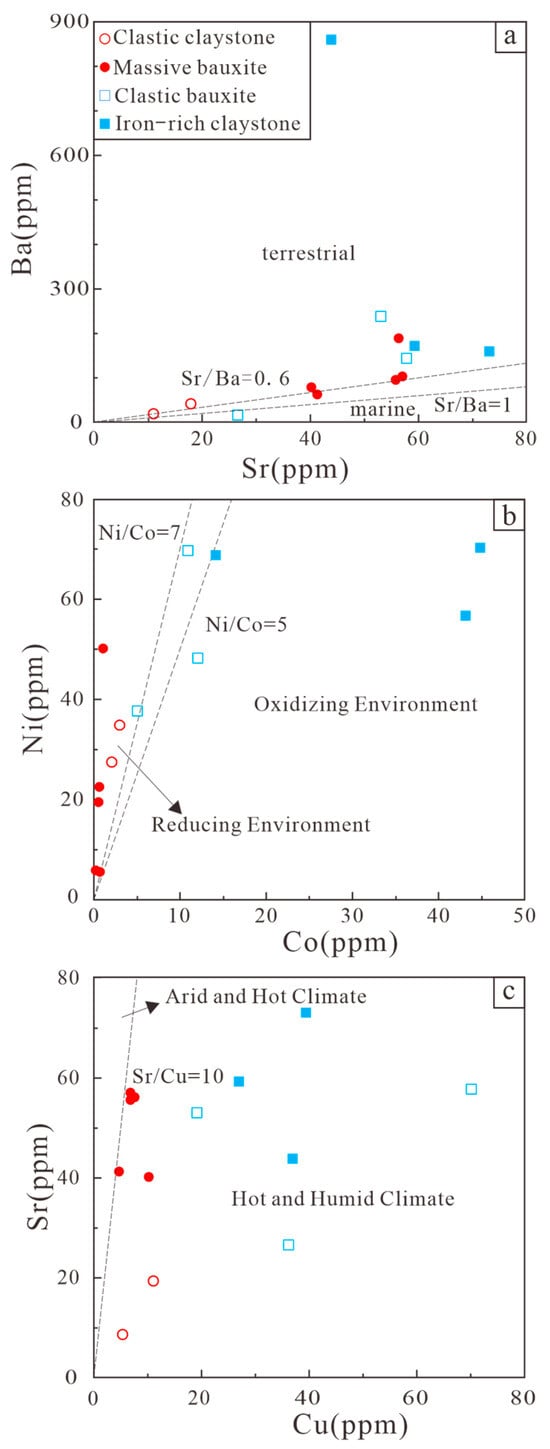
Figure 7.
Analysis of (a) Sr-Ba, (b) Co-Ni and (c) Cu-Sr depositional environments in the Dayancun profile.
Ni and Co are sensitive indicators for discriminating redox conditions. Compared to Ni, the rocks deposited under reducing conditions exhibited lower Co content and higher Ni/Co ratio over 7, while the sediments in the oxidizing environment possessed lower Ni/Co ratio less than 5 [47,52]. Lower part samples exhibited low Ni/Co ratios, with average Ni/Co ratios of the IC and CB layers being 2.58 and 5.94 (Figure 7b), respectively, indicating an oxidizing sedimentary environment [47]. The Ni/Co ratio of MB layer rapidly increased, ranging from 7.93 to 46.44 with an average of 30.54 (Figure 7b), indicating that the environment has transformed into a reduced state [47]. This result is also consistent with the fact that pyrite is well developed in this layer [48]. The changes in the Ni/Co ratio may also be jointly affected by sulfide minerals and diagenesis. The average Ni/Co ratio of the CC layer decreased to 10.52 and remained in a reduced environment (Figure 7b), but the degree of reduction decreased.
Bauxite is a climate-sensitive deposit generally found in tropical–subtropical humid and hot climates [1]. An Sr/Cu ratio less than 10 represents hot and humid climates [53]. The Sr/Cu ratios of the P1d samples from the Dayancun section were all below 10 (Figure 7c), showing their formation in a hot and humid climate.
The sedimentary environmental changes in the P1d from the Dayancun section were manifested as a transition from the oxidizing and terrestrial environments of the lower part to the reducing and seawater-involved environments of the upper part. The significant increases in the MgO content and Sr/Ba ratio in the MB layer both indicate a brief transgression event (Figure 7a). This event not only changed the sedimentary environment but also was more likely to bring new material sources, thus causing changes in the sedimentary process of the upper part of the Dazhuyuan Formation.
4.2. Material Source of P1d
4.2.1. Evidence of Geochemical Composition
Previous studies have indicated that the P1d formation originated from the weathering of the underlying bedrock, including C2h and S1–2hj [54,55]. During chemical weathering, REEs undergo significant fractionation that can be used to reflect the parent rock characteristics [56]. According to the North American Shale Composite (NASC) normalized REE distribution patterns (Figure 8), the lower part samples of the P1d show slight LREE enrichment, while the upper part samples exhibit reduced LREE content, relative enrichment of HREE, and a positive Eu anomaly in the MB layer. This feature suggests that the sedimentation of the P1d may have been influenced by continuous sedimentary recycling and changes in material sources. To further clarify the provenance, a comparison was made with the underlying bedrock (Figure 8c). The Upper Carboniferous Huanglong Formation (C2h) [57,58] samples have relatively low LREE content and display a positive Eu anomaly, whereas the Lower Silurian Hanjiadian Formation (S1–2hj) [57,58,59,60] samples all exhibit slight LREE enrichment. From the REE distribution (Figure 8), the features of the C2h samples differed from those of the P1d samples, ruling out the possibility that C2h is the main P1d source. The P1d samples relatively had a similar REE distribution to the S1–2hj samples (Figure 8), indicating that the S1–2hj shale is the main material source for the P1d.
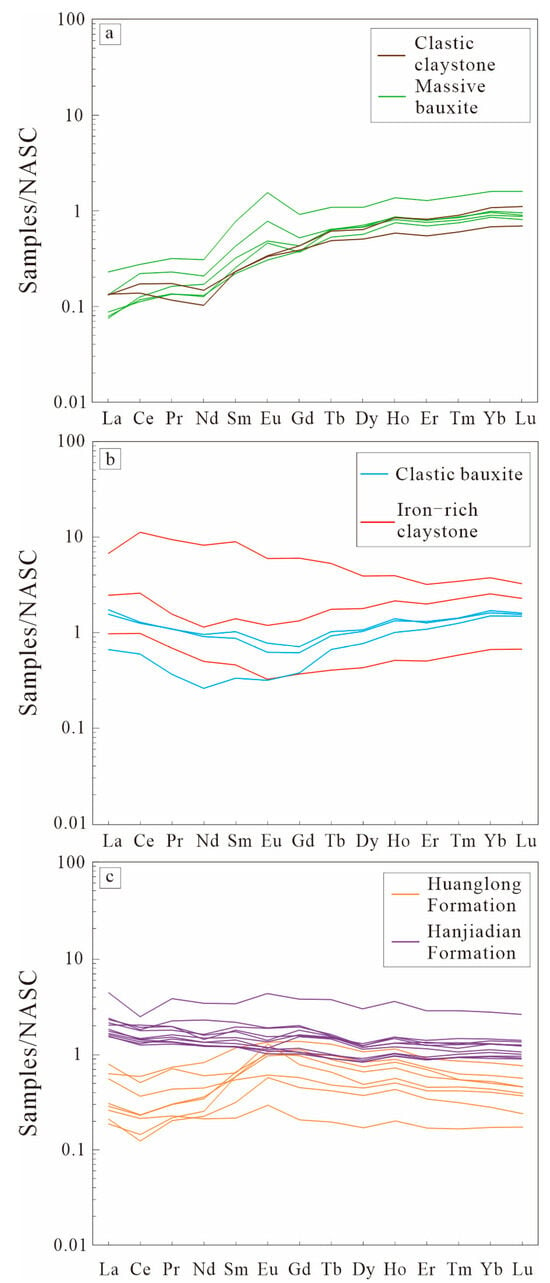
Figure 8.
North American Shale Composite (NASC) normalized rare earth elements distribution curves for the samples from (a) the clastic claystone and massive bauxite; (b) the clastic bauxite and iron-rich claystone; (c) the Huanglong Formation and Hanjiadian Formation. The normalizing values of NASC from Taylor and McLennan [61]. (The data of C2h and S1–2hj from [57,58,59,60]).
4.2.2. Evidence of Detrital Zircons
The zircon cathodoluminescence (CL) images in Figure 5 show that the five samples exhibit certain similarities in zircon morphology. Some zircons are prismatic, while others are fragmented and poorly rounded, with samples CC and MB containing relatively more fragmented grains. The oscillatory zoning observed in the CL images and high Th/U ratios (>0.1; Figure 6a) indicated a magmatic origin [62].
Most points lie on or near the concordia line (Figure 9), indicating that Pb loss is not widespread. The S1–2hj Formation yielded 31 concordant U-Pb ages, spanning 490~2560 Ma (Figure 9e,f). The IC and CB layers yielded 91 concordant U-Pb ages spanning 400~3280 Ma (Figure 9c,d), and the MB and CC layers yielded 100 concordant U-Pb ages spanning 420~3300 Ma (Figure 9a,b). The S1–2hj and P1d samples exhibited a zircon U–Pb age peak at ~960 Ma, with subordinate age peaks at ~530, ~1730, and ~2480 Ma (Figure 10). The P1d had a similar distribution of U–Pb ages of detrital zircon to S1–2hj (Figure 10), indicating that S1–2hj provided source for the P1d. Statistical analysis of specific zircon age populations reveals that in the 700–800 Ma range, the S1–2hj contains 12.9% of its zircons, a proportion similar to the 15.4% found in the IC and CB layers. In contrast, this percentage decreases significantly to 6% in the MC and CC layers. For the 1100–1200 Ma range, no zircons were detected in the S1–2hj, and the IC and CB layers contain only 1.1%. However, this proportion increases to 7% in the MC and CC layers. The IC, CB, and S1–2hj samples exhibited a second zircon U–Pb age peak at ~770 Ma (Figure 10b,d). The IC and CB layers had a highly similar distribution of U–Pb ages of detrital zircon to S1–2hj (Figure 10b,d), indicating that lower part of P1d directly originated from the S1–2hj weathering. For the MB and CC layers, there is still one dominant age peak of ~960 Ma consistent with the P1d (Figure 10a), suggesting that the S1–2hj is still an important material source for upper part of the P1d. However, the upper part samples had no dominant age peak of ~770 Ma and had a new subordinate age peak of ~1150 Ma (Figure 10a). This indicates that other sources besides the S1–2hj also contribute to upper part of the P1d. The detrital zircon U–Pb ages of the C2h peaked at 827 Ma [63], which was missing in all four layers of the P1d (Figure 10), further ruling out the possibility of the C2h as the main P1d source. The Dayancun section shows a complex detrital zircon U–Pb age spectrum, which may reflect the supply of multiple provenances.
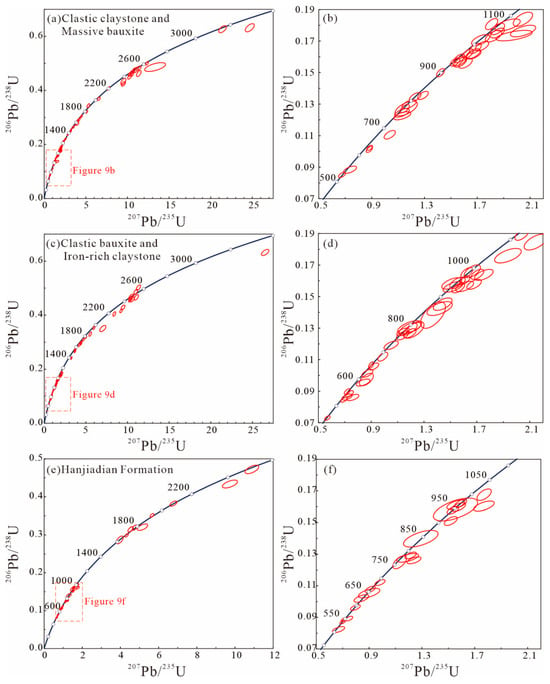
Figure 9.
Zircon U-Pb dating concordia diagrams of (a,b) clastic claystone and massive bauxite samples; (c,d) clastic bauxite and iron-rich claystone samples; and (e,f) Hanjiadian Formation samples.
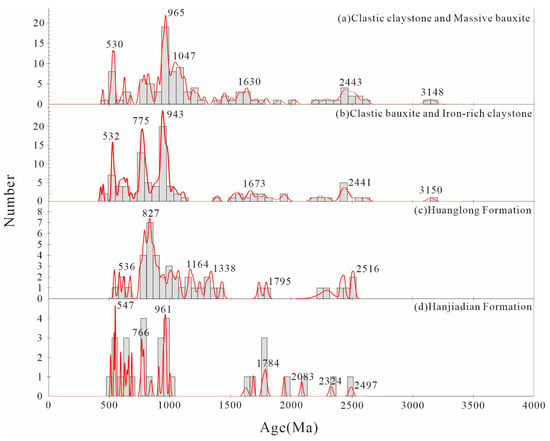
Figure 10.
Frequency histogram of U-Pb ages of detrital zircon from the Dayancun section (Data for C2h from [63]).
The dominant U–Pb age peaks of the P1d samples from the Dayancun section were approximately 930–990 and 750–780 Ma, with subordinate age peaks of 520–550 Ma. The ca. 930–990 and 750–780 Ma two-stage magmatism corresponded to the assembly and breakup of the Rodinia supercontinent [64,65]. The ages of 930–990 Ma corresponded to the Grenvillian collisional orogeny between the Yangtze and Cathaysia blocks [65]. The ages of 750–780 Ma corresponded to the breakup of the Rodinia supercontinent [64] characterized by rift basin development and bimodal volcanic activity in the Yangtze Block [66]. The persistent 930–990 Ma zircon age peak in the Dayancun P1d coupled with the absence of the 750–780 Ma peak and the emergence of a 1030–1150 Ma subpeak in the MB and CC layers revealed a phased provenance transition.
The Neoproterozoic rift-related volcanics and the Grenvillian collisional granites contributed to the lower part sedimentary deposits of the P1d [65,67]. The magmatic rocks formed by the global orogenic magmatism were uplifted, eroding through the Caledonian tectonic movement (430–460 Ma; [68]) after undergoing long-term erosion–deposition cycles [63] and ultimately contributing to the upper part sedimentary deposits of the P1d.
4.3. Sedimentary Processes
Previous studies on the Al-bearing rock series in northern Guizhou mostly focused on geological features [31], metallogenic model of bauxite [11,15], and Li distribution and occurrence [15,22]. The current views suggest that the Al-bearing rock series in northern Guizhou is affected by weathering, with silicon being continuously lost and aluminum being enriched. The typical structure of the P1d from bottom to top is claystone, aluminum claystone, and bauxite ore [54,69], which may have more than one rotary cycle [20,70]. From the IC layer to the CB layer, increasing Al2O3 and SiO2 contents indicate the weathering-related enrichment of aluminosilicate minerals, such as kaolinite [71]. However, the Al2O3 content suddenly increased to ~50%, while the SiO2 content decreased to ~30% in the MB layer (Figure 11a). A continuous weathering process cannot explain these changes. The variation patterns of the MB and CC layers were consistent (Figure 11a). SiO2 content continues to increase, whereas Al2O3 decreases. In addition, the significant increase in the MgO content (Figure 11b), a sharp decrease in the TFe2O3 content (Figure 11c), the deviation of Al2O3 - Zr data points from the trends of the IC and CB layers (Figure 11d), and the characteristics revealed in Figure 5 within the MB layer were also observed. The result is inconsistent with the previous view that Si loss and Al enrichment occur continuously (e.g., [54]).

Figure 11.
Diagrams of the correlation of major elements in the Dayancun section. (a) Al2O3- SiO2; (b) Al2O3-MgO; (c) Al2O3-TFe2O3; and (d) Al2O3-Zr.
Based on the changes in lithology (Figure 2), mineral composition (Figure 3), and major elements (Figure 11) of the P1d from the Dayancun section, its sedimentary process is divided into upper and lower layers. The lower part is from the IC layer to the CB layer. The Al2O3 and SiO2 contents gradually increase (Figure 11a), which corresponds to the continuous enrichment of kaolinite and other clay minerals. The TFe2O3 content gradually decreases (Figure 11c), corresponding to the leaching and migration of hematite in an oxidizing environment. Lower part is a process of the gradual intensification of weathering and bauxite mineralization. Upper part is from the MB layer to the CC layer, where the Al2O3 and MgO contents suddenly increase, and then continue to decrease (Figure 11b), corresponding to the addition and formation of chlorite and other Mg-bearing minerals. The Al2O3 content initially increased sharply and then continued to decrease, while the SiO2 content showed a gradual increase concurrently (Figure 11a). These suggest a change in sedimentary environment and the addition of new sources. The locally visible carbonaceous shale between the two parts [15] also suggests the discontinuous depositional process.
In the Early Permian, northern Guizhou was located near the equator [72]. Under hot and humid climatic conditions. Similarly to the previous studies [73], when the Al2O3 content was below 50%, the Li content was positively correlated with it (Figure 12a). The S1-2hj shale was weathered and transported to an oxidized and terrestrial environment (Figure 7), forming the IC and CB layers of lower part. During this part, as the sedimentation progressed, the Al2O3 and SiO2 contents gradually increased (Figure 12a–b), while the Al2O3/SiO2 (A/S) ratio and the MgO content slightly changed (Figure 12c–d). This reflects that the material source was mainly the weathering products of the S1-2hj Formation. The decrease in Zr content coupled with a sharp increase in Li content in the MB layer (Figure 12e) indicates that, influenced by a brief transgressive event (Figure 7; [30]), new Mg and Li rich source materials, in addition to the S1-2hj shale, were delivered to the Dayancun section. This influx triggered a concurrent, sharp increase in both MgO and Li contents within the MB layer (Figure 12d), resulting in the significant enrichment of Li (Figure 5). Meanwhile, the MB layer had a TFe2O3 content equivalent to the MgO content (Figure 12f) and a significantly lower K2O content (Figure 12g), indicating that the minerals of this layer are characterized by being Mg-rich and K-poor. Based on the laser ablation inductively coupled plasma mass spectrometry (LA-ICP-MS) analysis of clay minerals from the P1d in the Danping deposit of northern Guizhou, Liu et al. [15] proposed that chlorite is the main Mg-rich mineral. The REEs were significantly enriched at the base of the section (Figure 5), influenced by iron-bearing minerals at the bottom and pore waters introduced by transgression [22]. The sedimentary process of the upper part was distinct from that of the lower part and was governed by a combination of new source input, the formation of specific chlorite minerals, and fluid activities induced by sea-level fluctuations [6], which collectively resulted in the formation of unique elemental enrichment characteristics.
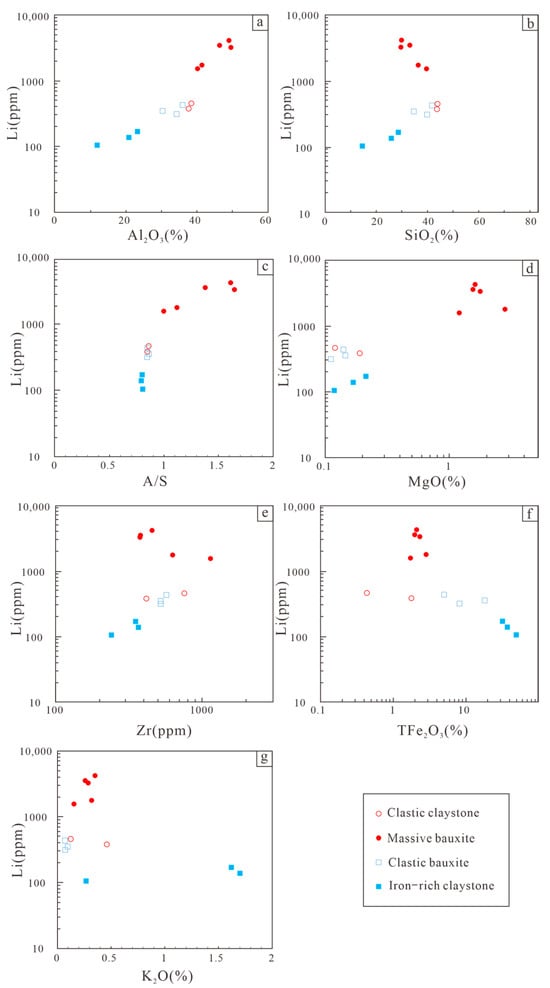
Figure 12.
Illustration of the correlation between Li and major elements in the Dayancun profile. (a) Al2O3-Li; (b) SiO2-Li; (c) A/S-Li; (d) MgO-Li; (e) Zr-Li; (f) TFe2O3-Li; and (g) K2O-Li.
5. Conclusions
The following conclusions are drawn based on the analysis of the whole-rock geochemical composition and the detrital zircon U–Pb ages of samples from the Dayancun section (northern Guizhou, Southwest China):
- (1)
- The iron-rich claystone, clastic bauxite, massive bauxite and clastic claystone layers of P1d from the Dayancun section were identified based on the lithologic changes. The Lower Permian Dazhuyuan Formation (P1d) can be divided into two parts.
- (2)
- Lower part layers were deposited in an oxidized and alkaline terrestrial environment. Minor seawater was involved in upper part, and the reduced and acidic environment became dominant.
- (3)
- The Lower to Middle Silurian Hanjiadian Formation (S1–2hj) shale, rather than the Upper Carboniferous Huanglong Formation (C2h) limestone, provides the dominant material source for the Lower Permian Dazhuyuan Formation (P1d). In upper part, seawater brings a new material source rich in Mg and Li.
- (4)
- The changes in the sedimentary environment and the involvement of seawater led to the uneven distribution of elements in the Dayancun Section.
Supplementary Materials
The following supporting information can be downloaded at: https://www.mdpi.com/article/10.3390/min15111167/s1, Supplementary Materials S1: Major and trace element contents in the Al-bearing rocks of the Dazhuyuan For-mation; Supplementary Materials S2: LA-ICP-MS U-Pb detrital zircon ages and trace element data for the Al-bearing rock series of the Dazhuyuan Formation and the Hanjialing strata.
Author Contributions
Writing—original draft, conceptualization, methodology, data curation, formal analysis, Z.L.; conceptualization, methodology, investigation, resources, writing—review and editing, supervision, project administration, funding acquisition, P.C.; funding acquisition, resources, B.Y.; resources, H.C., Y.F. and Q.Z.; investigation, R.M. and L.Q. All authors have read and agreed to the published version of the manuscript.
Funding
This work was financially supported by the National Natural Science Foundation of China (No. 42102084), and Geological Surveying Project of China Geological Survey (Nos. DD20230355, DD20230356), and Science and Technology Foundation of Guizhou Province (ZK[2022]041).
Data Availability Statement
The original contributions presented in this study are included in the article/Supplementary Materials. Further inquiries can be directed to the corresponding authors.
Conflicts of Interest
The authors declare that they have no known competing financial interests or personal relationships that could have appeared to influence the work reported in this paper.
References
- Bárdossy, G. Karst Bauxites-Bauxite Deposits on Carbonate Rocks; Elsevier: Amsterdam, The Netherlands, 1982; Volume 14. [Google Scholar]
- U.S. Geological Survey. Mineral Commodity Summaries 2023: Bauxite and Alumina; U.S. Geological Survey: Reston, VA, USA, 2023.
- Sun, L.; Zhang, S.; Zhang, S.; Liu, J.; Xiao, K. Geologic Characteristics and Potential of Bauxite in China. Ore Geol. Rev. 2020, 120, 103278. [Google Scholar] [CrossRef]
- Zhang, J.-Y.; Wang, Q.; Liu, X.-F.; Zhou, G.-F.; Xu, H.-P.; Zhu, Y.-G. Provenance and Ore-Forming Process of Permian Lithium-Rich Bauxite in Central Yunnan, SW China. Ore Geol. Rev. 2022, 145, 104862. [Google Scholar] [CrossRef]
- Mongelli, G.; Mameli, P.; Sinisi, R.; Buccione, R.; Oggiano, G. Rees and Other Critical Raw Materials in Cretaceous Mediterranean-Type Bauxite: The Case of the Sardinian Ore (Italy). Ore Geol. Rev. 2021, 139, 104559. [Google Scholar] [CrossRef]
- Economou-Eliopoulos, M.; Kanellopoulos, C. Abundance and Genetic Significance of Lithium in Karst-Type Bauxite Deposits: A Comparative Review. Minerals 2023, 13, 962. [Google Scholar] [CrossRef]
- Jin, W.; Che, X.; Wang, R.; Xu, Z.; Hu, H.; Zhang, R.; Li, G.; Zheng, B. The Deep Rare Metal Metallogenic Characteristics of the Jiajika Lithium Polymetallic Deposit in Sichuan Province, China: Revealed by the Jiajika Scientific Drilling. Ore Geol. Rev. 2023, 160, 105579. [Google Scholar] [CrossRef]
- Malhi, G.S.; Gessler, D.; Outhred, T. The Use of Lithium for the Treatment of Bipolar Disorder: Recommendations from Clinical Practice Guidelines. J. Affect. Disord. 2017, 217, 266–280. [Google Scholar] [CrossRef]
- Rioja, R.J.; Liu, J. The Evolution of Al-Li Base Products for Aerospace and Space Applications. Metall. Mater. Trans. A 2012, 43, 3325–3337. [Google Scholar] [CrossRef]
- Vikström, H.; Davidsson, S.; Höök, M. Lithium Availability and Future Production Outlooks. Appl. Energy 2013, 110, 252–266. [Google Scholar] [CrossRef]
- Tang, B.; Fu, Y.; Yan, S.; Chen, P.-W.; Cao, C.; Guo, C.; Wu, P.; Long, Z.; Long, K.-S.; Wang, T.-S.; et al. The Source, Host Minerals, and Enrichment Mechanism of Lithium in the Xinmin Bauxite Deposit, Northern Guizhou, China: Constraints from Lithium Isotopes. Ore Geol. Rev. 2022, 141, 104653. [Google Scholar] [CrossRef]
- Deng, X.; Yu, W.; Du, Y.; Du, W.; Xiong, X.; Zheng, Y.; Long, J.; Zhang, H.; Fu, H.; He, B.; et al. Discovery and Significance of Shixi Bauxitite—Type Lithium Deposit in Guizhou Province. Geol. Rev. 2023, 69, 133–147. [Google Scholar] [CrossRef]
- Jin, Z.; Zhou, J.; Huang, Z.; Dai, L.; Xie, X.; Peng, S.; Gu, J. The Distribution of Associated Elements Li, Sc and Ga in the Typical Bauxited Eposits over the Wuchuan–Zheng’an–Daozhen Bauxite Ore District, Northern Guizhou Province. Geol. China 2015, 42, 1910–1918. [Google Scholar] [CrossRef]
- Long, Z.; Fu, Y.; He, W.; Tang, B.; Long, K.; Liu, Y.; Wang, T. Geochemical Characteristics and Enrichment Mechanism of Li in Xinminbauxite Deposit, Guizhou. Miner. Depos. 2021, 40, 873–890. [Google Scholar] [CrossRef]
- Liu, B.; Chen, P.; Wang, T.; Sun, G.; Duan, M.; Hou, K.; Zeng, Q.; Fu, Y. Genesis of Danping Bauxite (Northern Guizhou, China) and Associated Lithium: Evidence from LA-ICP-MS Analysis of Al-Bearing Minerals. J. Geochem. Explor. 2024, 262, 107464. [Google Scholar] [CrossRef]
- Gu, J.; Huang, Z.; Fan, H.; Jin, Z.; Yan, Z.; Zhang, J. Mineralogy, Geochemistry, and Genesis of Lateritic Bauxite Deposits in the Wuchuan–Zheng’an–Daozhen Area, Northern Guizhou Province, China. J. Geochem. Explor. 2013, 130, 44–59. [Google Scholar] [CrossRef]
- Zhang, B.; Qi, F.; Gao, X.; Li, X.; Shang, Y.; Kong, Z.; Jia, L.; Meng, J.; Guo, H.; Fang, F.; et al. Geological Characteristics, Metallogenic Regularity, and Research Progress of Lithium Deposits in China. China Geol. 2022, 5, 734–767. [Google Scholar] [CrossRef]
- Wang, R.; Wang, Q.; Huang, Y.; Yang, S.; Liu, X.; Zhou, Q. Combined Tectonic and Paleogeographic Controls on the Genesis of Bauxite in the Early Carboniferous to Permian Central Yangtze Island. Ore Geol. Rev. 2018, 101, 468–480. [Google Scholar] [CrossRef]
- Liu, P.; Liao, Y.; Zhang, Y. The Sedimentary Environment and Formation Mechanism of Bauxite-Bearingrock Series in Dazhuyuan Area, Northern Guizhou Province. Geol. China 2016, 43, 2173–2190. [Google Scholar] [CrossRef]
- Yu, W.; Algeo, T.J.; Yan, J.; Yang, J.; Du, Y.; Huang, X.; Weng, S. Climatic and Hydrologic Controls on Upper Paleozoic Bauxite Deposits in South China. Earth-Sci. Rev. 2019, 189, 159–176. [Google Scholar] [CrossRef]
- Zhao, Z.; Wang, D.; Li, P.; Lei, Z. Detrital Zircon U-Pb Geochronology of the Dazhuyuan Formation inNorthern Guizhou: Implications for Bauxite Mineralization. Rock Miner. Anal. 2013, 32, 166–173. [Google Scholar] [CrossRef]
- Li, H.; Fan, H.; Zhang, J.; Huang, Z.; Jiang, C.; Ye, L.; Wu, L. Distribution and Enrichment Mechanism of Critical Metals in the Danping Bauxite Deposit, Northern Guizhou (SW China). Ore Geol. Rev. 2023, 161, 105670. [Google Scholar] [CrossRef]
- Chen, P.; Liu, B.; Wang, T.; Zhou, L.; Wang, Y.; Sun, G.; Hou, K.; Weng, S.; Zeng, Q.; Long, Z.; et al. Genesis of the Danping Bauxite Deposit in Northern Guizhou, Southwest China: Constraints from in-Situ Elemental and Sulfur Isotope Analyses in Pyrite. Ore Geol. Rev. 2022, 148, 105056. [Google Scholar] [CrossRef]
- Zhao, G.; Guo, J. Precambrian Geology of China: Preface. Precambr. Res. 2012, 222–223, 1–12. [Google Scholar] [CrossRef]
- Liu, S.; Yang, Y.; Deng, B.; Zhong, Y.; Wen, L.; Sun, W.; Li, Z.; Jansa, L.; Li, J.; Song, J.; et al. Tectonic Evolution of the Sichuan Basin, Southwest China. Earth-Sci. Rev. 2021, 213, 103470. [Google Scholar] [CrossRef]
- Wang, R.; Ding, W.; Gong, D.; Leng, J.; Wang, X.; Yin, S.; Sun, Y. Gas Preservation Conditions of Marine Shale in Northern Guizhou Area: A Case Study of the Lower Cambrian Niutitang Formation in the Cen’gong block, Guizhou Province. Oil Gas Geol. 2016, 37, 45–55. [Google Scholar] [CrossRef]
- Chen, Y.; Chen, Y. The Discovery of Conodont at the Top Part of Loushanguan Group in Zunyi, Guizhou and Its Significance. Guizhou Geol. 1990, 7, 373–377. [Google Scholar]
- Li, S.; Xiao, K.; Wo, Y.; Long, S.; Cai, L. REE Geochemical Characteristics and Their Geological Signification in Silurian, West of Hunan Province and North of Guizhou Province. Geoscience 2008, 22, 273–280. [Google Scholar]
- Cui, T.; Jiao, Y.; Du, Y.; Wang, X.; Lei, Z.; Weng, S.; Jin, Z. Sedimentary Palaeogeography and Its Mineralization Significance of the Early Permian Bauxite in Wuchuan-Zheng’an-Daozhen Area, Northern Guizhou Province. J. Palaeogeogr. 2014, 16, 9–18. [Google Scholar] [CrossRef]
- Huang, X.; Zhang, X.; Du, S.; Qie, W.; Yang, B.; Duan, X. Control of Sea-Level Changes over the Forming of Bauxite between Carboniferous and Permian in Northern Guizhou and Adjacent Regions. Bull. Geol. Sci. Technol. 2013, 32, 80–86. [Google Scholar]
- Li, P.; Yu, W.; Du, Y.; Lai, X.; Weng, S.; Pang, D.; Xiong, G.; Lei, Z.; Zhao, S.; Yang, S. Influence of Geomorphology and Leaching on the Formation of Permian Bauxite in Northern Guizhou Province, South China. J. Geochem. Explor. 2020, 210, 106446. [Google Scholar] [CrossRef]
- Du, Y.; Huang, H.; Yang, J.; Huang, H.; Tao, P.; Huang, Z.; Hu, L.; Xie, C. The Basin Translation from Late Paleozoic to Triassic of the Youjiang Basin and Its Tectonic Signification. Geol. Rev. 2013, 59, 1–12. [Google Scholar]
- Qin, S.; Zhang, M.; Gong, M.; Kuang, Z. Indosinian Movement in Guizhou. Sediment. Geol. Tethyan Geol. 2009, 29, 100–103. [Google Scholar]
- Gu, J.; Huang, Z.; Fan, H.; Ye, L.; Jin, Z. Provenance of Lateritic Bauxite Deposits in the Wuchuan–Zheng’an–Daozhen Area, Northern Guizhou Province, China: LA-ICP-MS and SIMS U–Pb Dating of Detrital Zircons. J. Asian Earth Sci. 2013, 70–71, 265–282. [Google Scholar] [CrossRef]
- Raczek, I.; Stoll, B.; Hofmann, A.W.; Peter Jochum, K. High-Precision Trace Element Data for the USGS Reference Materials BCR-1, BCR-2, BHVO-1, BHVO-2, AGV-1, AGV-2, DTS-1, DTS-2, GSP-1 and GSP-2 by ID-TIMS and MIC-SSMS. Geostand. Newsl. 2001, 25, 77–86. [Google Scholar] [CrossRef]
- Li, G.; Xu, L.; Zhang, Y.; Zhong, P. X-Ray Fluorescence Spectrometric Determination of Twenty FiveMajor and Trace Elements in Stream Sediraents. Rock Miner. Anal. 1987, 6, 15–23. [Google Scholar]
- Zhang, Q.; Fan, S.; Pan, Y.; Li, G. Determination of 25 Major, Minor and Trace Elements in Geochemical Exploration Samples by X-Ray Fluorescence Spectrometry. Rock Miner. Anal. 2004, 23, 19–24. [Google Scholar]
- Eggins, S.M.; Woodhead, J.D.; Kinsley, L.P.J.; Mortimer, G.E.; Sylvester, P.; McCulloch, M.T.; Hergt, J.M.; Handler, M.R. A Simple Method for the Precise Determination of ≥40 Trace Elements in Geological Samples by ICPMS Using Enriched Isotope Internal Standardisation. Chem. Geol. 1997, 134, 311–326. [Google Scholar] [CrossRef]
- Jochum, K.P.; Weis, U.; Schwager, B.; Stoll, B.; Wilson, S.A.; Haug, G.H.; Andreae, M.O.; Enzweiler, J. Reference Values Following ISO Guidelines for Frequently Requested Rock Reference Materials. Geostand. Geoanal. Res. 2016, 40, 333–350. [Google Scholar] [CrossRef]
- Wiedenbeck, M.; Allé, P.; Corfu, F.; Griffin, W.L.; Meier, M.; Oberli, F.; von Quadt, A.; Roddick, J.C.; Spiegel, W. Three Natural Zircon Standards for U-Th-Pb, Lu-Hf, Trace Element and REE Analyses. Geostand. Newsl. 1995, 19, 1–23. [Google Scholar] [CrossRef]
- Jackson, S.E.; Pearson, N.J.; Griffin, W.L.; Belousova, E.A. The Application of Laser Ablation-Inductively Coupled Plasma-Mass Spectrometry to in Situ U–Pb Zircon Geochronology. Chem. Geol. 2004, 211, 47–69. [Google Scholar] [CrossRef]
- Sláma, J.; Košler, J.; Condon, D.J.; Crowley, J.L.; Gerdes, A.; Hanchar, J.M.; Horstwood, M.S.A.; Morris, G.A.; Nasdala, L.; Norberg, N.; et al. Plešovice Zircon—A New Natural Reference Material for U–Pb and Hf Isotopic Microanalysis. Chem. Geol. 2008, 249, 1–35. [Google Scholar] [CrossRef]
- Hu, Z.; Li, X.-H.; Luo, T.; Zhang, W.; Crowley, J.; Li, Q.; Ling, X.; Yang, C.; Li, Y.; Feng, L.; et al. Tanz Zircon Megacrysts: A New Zircon Reference Material for the Microbeam Determination of U–Pb Ages and Zr–O Isotopes. J. Anal. At. Spectrom. 2021, 36, 2715–2734. [Google Scholar] [CrossRef]
- Liu, Y.; Hu, Z.; Gao, S.; Günther, D.; Xu, J.; Gao, C.; Chen, H. In Situ Analysis of Major and Trace Elements of Anhydrous Minerals by LA-ICP-MS without Applying an Internal Standard. Chem. Geol. 2008, 257, 34–43. [Google Scholar] [CrossRef]
- Ludwig, K.R. Isoplot 3.00: A Geochronological Toolkit for Microsoft Excel; Berkeley Geochronology Center: Berkeley, CA, USA, 2003. [Google Scholar]
- Li, H.; Fan, H.; Zhang, J.; Zhang, Y.; Huang, Z. Enrichment of Associated Elements in Ore-Bearing Rock Series from theDanping Bauxite Deposit, Northern Guizhou, China. Acta Mineral. Sin. 2021, 41, 427–438. [Google Scholar] [CrossRef]
- Jones, B.; Manning, D.A.C. Comparison of Geochemical Indices Used for the Interpretation of Palaeoredox Conditions in Ancient Mudstones. Chem. Geol. 1994, 111, 111–129. [Google Scholar] [CrossRef]
- Tribovillard, N.; Algeo, T.J.; Lyons, T.; Riboulleau, A. Trace Metals as Paleoredox and Paleoproductivity Proxies: An Update. Chem. Geol. 2006, 232, 12–32. [Google Scholar] [CrossRef]
- Boxleiter, A.; Wen, Y.; Tang, Y.; Elliott, W.C. Rare-Earth Element (REE) Remobilization and Fractionation in Bauxite Zones from Sedimentary Kaolin Deposits, Western Georgia (USA), Upper Coastal Plain. Chem. Geol. 2024, 660, 122151. [Google Scholar] [CrossRef]
- Li, Y.-H.; Chan, L.-H. Desorption of Ba and226Ra from River-Borne Sediments in the Hudson Estuary. Earth Planet. Sci. Lett. 1979, 43, 343–350. [Google Scholar] [CrossRef]
- McManus, J.; Berelson, W.M.; Klinkhammer, G.P.; Johnson, K.S.; Coale, K.H.; Anderson, R.F.; Kumar, N.; Burdige, D.J.; Hammond, D.E.; Brumsack, H.J.; et al. Geochemistry of Barium in Marine Sediments: Implications for Its Use as a Paleoproxy. Geochim. Cosmochim. Acta 1998, 62, 3453–3473. [Google Scholar] [CrossRef]
- Lewan, M.D.; Maynard, J.B. Factors Controlling Enrichment of Vanadium and Nickel in the Bitumen of Organic Sedimentary Rocks. Geochim. Cosmochim. Acta 1982, 46, 2547–2560. [Google Scholar] [CrossRef]
- Qu, C.-S.; Qiu, L.-W.; Cao, Y.-C.; Yang, Y.-Q.; Yu, K.-H. Sedimentary Environment and the Controlling Factors of Organic-Rich Rocks in the Lucaogou Formation of the Jimusar Sag, Junggar Basin, NW China. Pet. Sci. 2019, 16, 763–775. [Google Scholar] [CrossRef]
- Jin, Z.; Liu, L.; Huang, Z.; Xiang, X.; Xie, X. Study on Weathering and Mineralization Mechanism of Bauxite in Wuzhengdao Area of Guizhou. Miner. Resour. Geol. 2012, 26, 469–475. [Google Scholar]
- Du, Y.; Yu, W. Subaerial Leaching Process of Sedimentary Bauxite Andthe Discussion on Classifications of Bauxite Deposits. J. Palaeogeogr. 2020, 22, 812–826. [Google Scholar] [CrossRef]
- Khosravi, M.; Abedini, A.; Alipour, S.; Mongelli, G. The Darzi-Vali Bauxite Deposit, West-Azarbaidjan Province, Iran: Critical Metals Distribution and Parental Affinities. J. Afr. Earth Sci. 2017, 129, 960–972. [Google Scholar] [CrossRef]
- Cui, T.; Jiao, Y.; Du, Y.; Wang, X.; Lei, Z.; Weng, S. Mineralogical and Geochemical Characteristic Ofbauxite in Northern Guizhou. Chin. J. Nonferrous Met. 2013, 23, 2905–2920. [Google Scholar]
- Wang, H.; Gu, J.; Huang, Z.; Zhao, L. The Migration and Enrichment of REE in the Formation Processof the Xinmin Bauxite Deposit in the Wuchuan-Zheng’an-Daozhen Area, Northern Guizhou, China. Acta Mineral. Sin. 2021, 41, 439–453. [Google Scholar] [CrossRef]
- Wang, X.; Jiao, Y.; Du, Y.; Zhou, Q.; Cui, T.; Ji, B.; Lei, Z.; Weng, S.; Jin, Z.; Xiong, X. Rare Earth Element Geochemistry of Bauxite in Wuchuan-Zheng’an-Daozhen Area, Northern Guizhou Province. Geol. Sci. Technol. Inf. 2013, 32, 27–33. [Google Scholar]
- Zhang, Y.; Ling, W.; Wu, H.; Zhang, Y.; Ding, X.; Cui, T.; Du, Y.; Lei, Z.; Weng, S. Geochemistry of Varied Type Ores of Northern Guizhou Bauxites and Its Implication for Mineralization. Geol. Sci. Technol. Inf. 2013, 32, 79. [Google Scholar]
- Taylor, S.; McLennan, S. The Continental Crust: Its Composition and Evolution; Blackwell Scientific: Hoboken, NJ, USA, 1985; p. 328. [Google Scholar]
- Rubatto, D. Zircon Trace Element Geochemistry: Partitioning with Garnet and the Link between U–Pb Ages and Metamorphism. Chem. Geol. 2002, 184, 123–138. [Google Scholar] [CrossRef]
- Xiang, X.; Jin, Z.; Huang, Z.; Zhou, J.; Gu, J. Origin of Ore-Forming Materials for Bauxite Deposits in Northern GuizhouProvince, China: Evidence from Detrial Zircon U-Pb Dating. Acta Mineral. Sin. 2015, 35, 465–472. [Google Scholar] [CrossRef]
- Zhou, J.-C.; Wang, X.-L.; Qiu, J.-S. Geochronology of Neoproterozoic Mafic Rocks and Sandstones from Northeastern Guizhou, South China: Coeval Arc Magmatism and Sedimentation. Precambr. Res. 2009, 170, 27–42. [Google Scholar] [CrossRef]
- Li, X.-H.; Li, Z.-X.; Sinclair, J.A.; Li, W.-X.; Carter, G. Revisiting the “Yanbian Terrane”: Implications for Neoproterozoic Tectonic Evolution of the Western Yangtze Block, South China. Precambr. Res. 2006, 151, 14–30. [Google Scholar] [CrossRef]
- Li, Z.X.; Li, X.H.; Kinny, P.D.; Wang, J.; Zhang, S.; Zhou, H. Geochronology of Neoproterozoic Syn-Rift Magmatism in the Yangtze Craton, South China and Correlations with Other Continents: Evidence for a Mantle Superplume That Broke up Rodinia. Precambr. Res. 2003, 122, 85–109. [Google Scholar] [CrossRef]
- Yang, J.; Wen, H.; Guo, X.; Luo, C.; Yu, W.; Du, S.; Cui, Y.; Zhao, B. Detrital Zircon U–Pb Ages and Trace Elements Indicate the Provenance of Early Carboniferous Li-Rich Claystone from Central Guizhou, South China. Sediment. Geol. 2022, 442, 106278. [Google Scholar] [CrossRef]
- Ma, C.; Ming, H.; Yang, K. An Ordovician Magmatic Arc at the Northern Foot of Dabie Mountains: Evidence from Geochronology and Geochemistry of Intrusive Rocks. Acta Petrol. Sin. 2004, 20, 393–402. [Google Scholar]
- Lei, Z.; Ling, W.; Wu, H.; Zhang, Y.; Zhang, Y. Geochemistry and Mineralization of the Permian Bauxites with Contrast Bedrocks in Northern Guizhou, South China. J. Earth Sci. 2023, 34, 487–503. [Google Scholar] [CrossRef]
- Hao, J.; Du, D.; Wang, Y.; Liu, Y.; Gong, H.; Ren, J. A Study on Sedimentary Age of Allite Formation in North of Guizhou. Acta Mineral. Sin. 2007, 27, 466–472. [Google Scholar] [CrossRef]
- Mo, H.; Yang, R.; Luo, C.; Li, X.; Ji, Y.; Yang, G.; Zhou, X.; Gao, C.; Hu, X.; Zeng, Z. Effect of Karst Geomorphology on the Sedimentary Mineralization and Geochemical Distribution of Bauxite: An Example from the Xiaoyuan Area in Qingzhen, Guizhou Province. Minerals 2023, 13, 1013. [Google Scholar] [CrossRef]
- Wang, J.; Li, H. Carboniferous Paleo-Latitude and Bauxite Deposit of Central Guizhou Province. Geochimica 1998, 27, 575–578. [Google Scholar] [CrossRef]
- Fan, H.; Ye, L.; Huang, Z. The Associated Lithium Resource in Bauxite (Bauxite-Bearing Rock). Acta Mineral. Sin. 2021, 41, 382–390. [Google Scholar] [CrossRef]
Disclaimer/Publisher’s Note: The statements, opinions and data contained in all publications are solely those of the individual author(s) and contributor(s) and not of MDPI and/or the editor(s). MDPI and/or the editor(s) disclaim responsibility for any injury to people or property resulting from any ideas, methods, instructions or products referred to in the content. |
© 2025 by the authors. Licensee MDPI, Basel, Switzerland. This article is an open access article distributed under the terms and conditions of the Creative Commons Attribution (CC BY) license (https://creativecommons.org/licenses/by/4.0/).